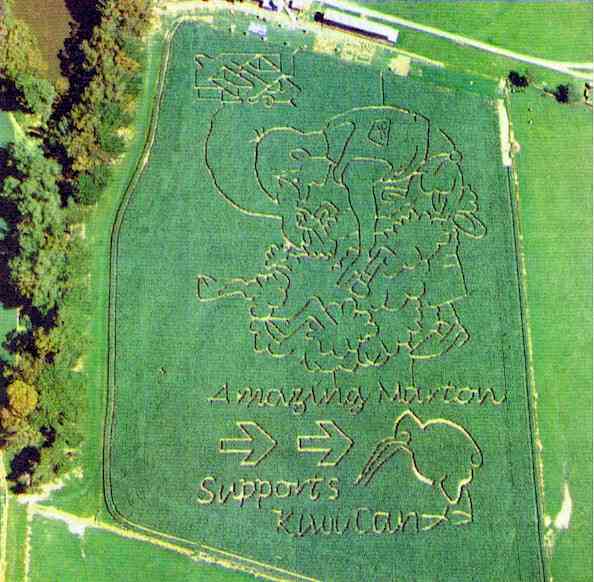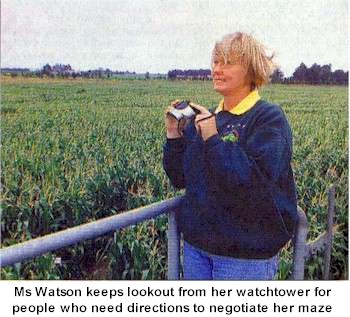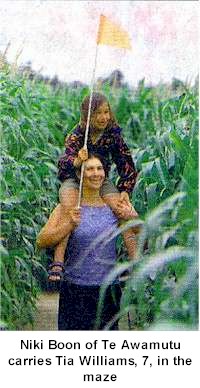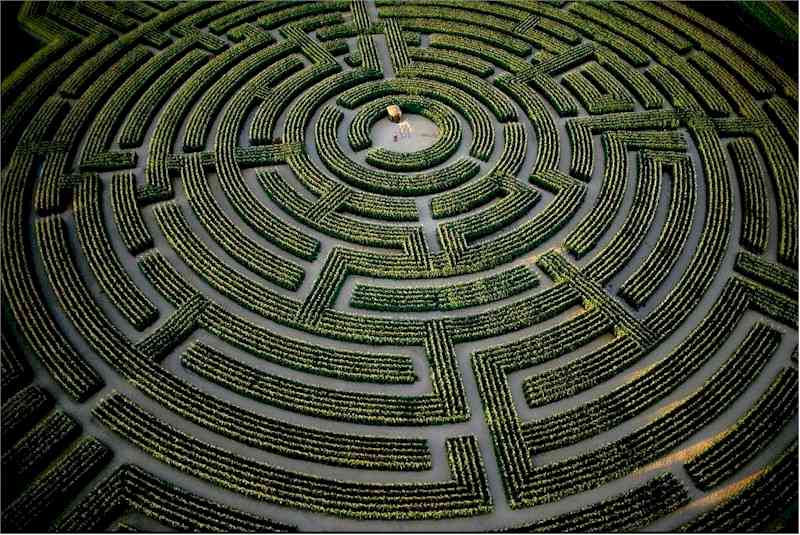Business is Growing
Rural EnterpriseBetter here than in Philadelphia - W C Fields' proposed epitaph
An aerial view of the maze Corn Field Maze Draws Crowds
Since the maze, a few kilometres north of Bulls on State Highway 1, was opened on Boxing Day, about 4,000 people have enjoyed the challenge of finding their way through four hectares of intricately-planted maize. Created by Beth Watson, the maze features more than five kilometres of meandering pathways. Participants carry "help" flags and if they become lost - as many do - they signal for directions to a spotter on a tower in the maze centre. Ms Watson said she was surprised at the maze's popularity. "I always felt it was a good idea, but it has exceeded what I expected." The busiest day was Wellington's Anniversary Day, when 600 people descended on the corn field.
The maze is the first of its kind in New Zealand, but only has a 12-week life span as the crop is to be harvested in May. It will close at Easter with a big Easter egg hunt. A typical New Zealand icon (a shearer), was selected by Ms Watson for the overall design, but she plans to change that next season - "it will be something rural, possibly a tractor." Forming the pathways was back-breaking work, as Ms Watson and her helpers crawled through the crop on hands and knees, removing newly sown plants with screwdrivers, the best tools for the task. It takes an average of 50 minutes to negotiate the entire maze, though one group revealed on the blackboard for longest daily time that it had taken the four hours. They then tried to explain it away by adding, "But we are Australians." Source: The Dominion Tuesday 30 January 2001 Photo credits for Ms Watson and Niki and Tia: Mark Round For lots more on mazes (including mirror mazes) and on formal gardens, please click here for page 2. (This is the only reference to that page; clicking "Up" at the bottom of that page will return you back to here.)
World's Largest Maze
The largest maze in the world, at Reignac-sur-Indre, Indre-et-Loire Department, France (N 47°13’-E 0°54’) In 1996, the year the largest plant maze in the world was created at Reignac-sur-Indre in Touraine, 85,000 visitors came to admire and lose themselves in the middle of its 4-hectare (10-acre) expanse. Each year, a maze of corn or sunflowers emerges from the ground over the summer, is harvested in the autumn, and then reappears the following year in a different form, thanks to a well-proven technique of sowing and marking out. This site takes its inspiration from an older tradition in the art of landscaping. During the Renaissance, Italian gardens spawned an abundance of mazes in which people could walk, get lost, hatch plots, and exchange gossip. This lightheartedness somewhat dispelled the sacred and sometimes threatening character of the great old labyrinths associated with Gothic cathedrals and with the Minotaur in Greece, or further back still the hundreds of stone labyrinths known as "Troy Towns," which are scattered along the shores of the Baltic. Were they used for sun rituals, for dancing, as Stations of the Cross, for initiation rites? You decide. Source: yannarthusbertrand.com from Earth from Above by the incomparable photographer Yann Arthus-Bertrand
Farmer's CurseThe Other Side of Eden: Hunters, Farmers and the Shaping of the World by Hugh Brody, Farrar Straus and Giroux To hear Hugh Brody tell it, factory farming is not the problem but farming itself. He is a renaissance man struggling to breast the waves of contemporary specialisation. He is a much-travelled writer, documentary film maker and field-worker, deeply passionate and knowledgeable about his primary subject, the hunter-gatherer people of the Canadian Arctic and sub-Arctic. He is also widely read in anthropology, philosophy, psychology, economic history, linguistics, literary criticism and theology. The Other Side of Eden draws on all parts of Mr Brody's intellectual life. It is sustained by a profound admiration and affection for hunter-gatherers - individually, collectively, philosophically and spiritually - and by a barely suppressed rage at what Mr Brody sees as the other, "cursed" (as explained in Genesis) force in the human story: farming. The farmers' system and philosophy, he insists, have condemned them to go forth and multiply, peopling the earth and expanding their domain to the detriment of hunter-gatherers, whose philosophy, based on respect for nature and for the equality and freedom of each individual, including children, was no match for the rapacity, technology and productivity of the newcomers. Mr Brody does not, however, advance his position by means of conventional argument. There is no direct assault, logically proceeding from issue to issue, with facts marshalled in a scholarly or quasi-legal fashion. Rather, he circles his prey, returning again and again to the same issue, firing an arrow here, knocking off a chip there and waiting, one feels, for the walls of Jericho finally to collapse at the nagging of his persistent trumpet. The sympathy of many readers will be engaged by Mr Brody's anecdotes, by the charm of the personal portraits he paints, by his evident humanity and by the plausibility of his thesis. He maintains that "our" materialistic and egotistical civilisation has much to learn from the more harmonious and generous culture of the hunter-gatherers; and that the curtailment and brutalisation of that culture, both in the wake of the agricultural revolution 12,000 years ago and then again in the modern colonising era after 1492, should weigh heavily on "our" consciences. Those who like their truths conveyed in more conventionally rigorous terms will be frustrated by Mr Brody's method, which, though it builds up a head of emotional steam, seems to dodge the final blast of the trumpet for which we feel we have been prepared. At the end Mr Brody says that "without the hunter-gatherers, humanity is diminished and cursed; with them we can achieve a more complete version of ourselves." Yet he never quite spells out what is nonetheless strongly implied: that the agricultural revolution led mankind astray ("out of Eden"), that the industrial revolution compounded this plunge into aggressive acquisitiveness, and that we should be better off and better people if neither of these things - the two main events in human economic history - had occurred. It is hard to attach much credence to a counterfactual proposition on such a heroic scale, implying as it does the non-existence then and now of all but a fragment of the human race, and the non-occurrence of almost everything known as "civilisation", warts and all. But that need not stop you enjoying Mr Brody's book, even if you hesitate to put him in charge of your destiny. Source: The Economist 3 March 2001 See also:
And finally... Watch My FlockMake like a shepherd and get the flock out of here... I saw the following advertisement in a Wellington newspaper. Clearly, those living in the South Island would see such an ad as commonplace. My background, however, is not like theirs. I don't know why it appealed to me so much - perhaps because it sounded so bucolic, pastoral, rural, rustic, countrified, idyllic and green?
For articles related to working including why, which career, bosses, time constraints, focus, trends, gender issues, pay differentials, getting laid off, getting re-hired, dependents, part-time work
and balancing work and values click the "Up" button below to take you to the Index page for this section on Working. |
 Animals
Animals Animation
Animation Art of Playing Cards
Art of Playing Cards Drugs
Drugs Education
Education Environment
Environment Flying
Flying History
History Humour
Humour Immigration
Immigration Info/Tech
Info/Tech Intellectual/Entertaining
Intellectual/Entertaining Lifestyles
Lifestyles Men
Men Money/Politics/Law
Money/Politics/Law New Jersey
New Jersey Odds and Oddities
Odds and Oddities Older & Under
Older & Under Photography
Photography Prisons
Prisons Relationships
Relationships Science
Science Social/Cultural
Social/Cultural Terrorism
Terrorism Wellington
Wellington Working
Working Zero Return Investment
Zero Return Investment
 Everybody's amazed, including the designer, at the popularity of the Amazing Maze 'n Maize 'n
Marton.
Everybody's amazed, including the designer, at the popularity of the Amazing Maze 'n Maize 'n
Marton. Ms Watson got her idea underway after completing a postgraduate course in rural
tourism and spotting a maize maze on the Internet. She keeps in regular contact with a woman in Idaho who runs a similar venture.
Ms Watson got her idea underway after completing a postgraduate course in rural
tourism and spotting a maize maze on the Internet. She keeps in regular contact with a woman in Idaho who runs a similar venture.